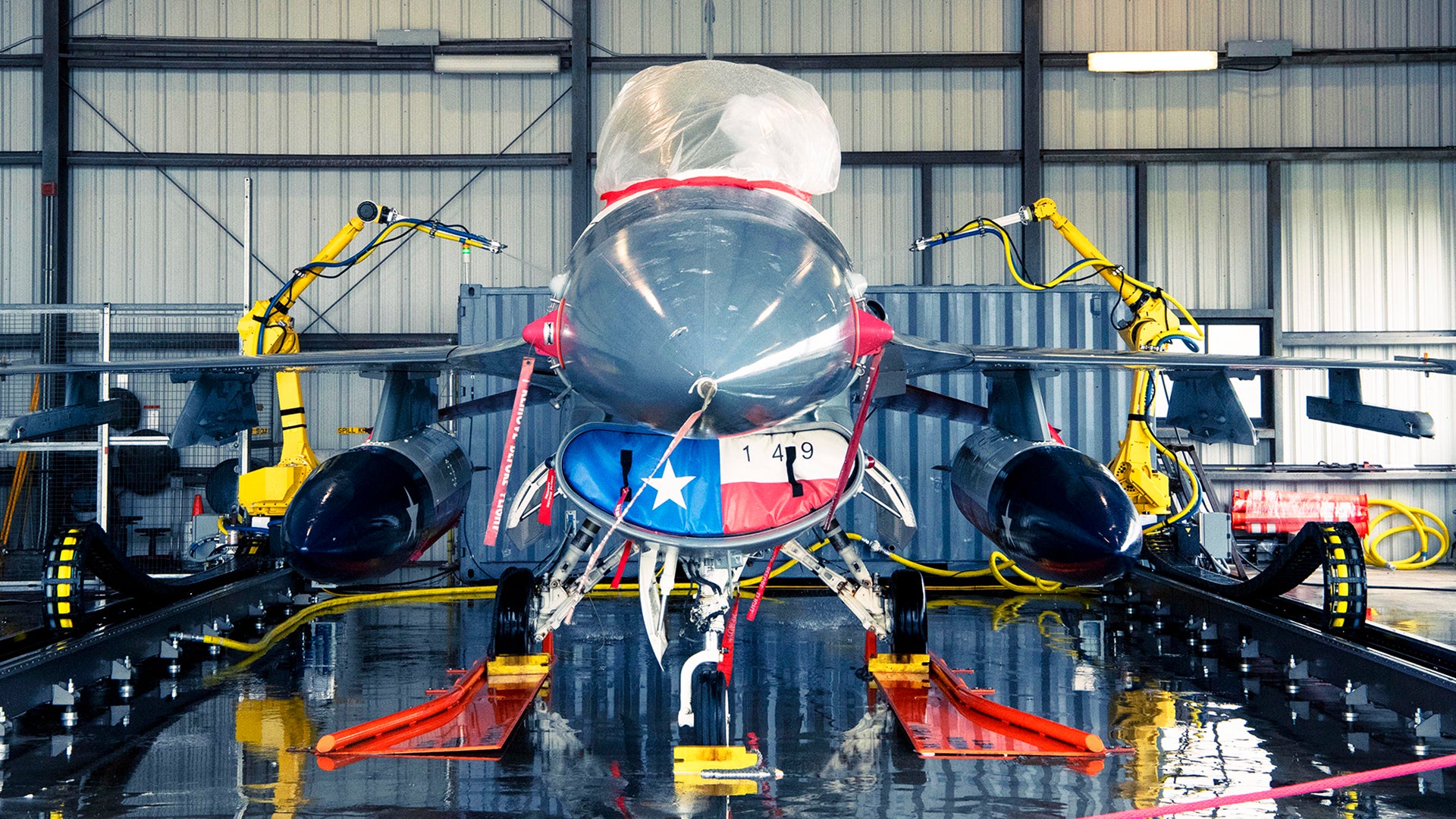The U.S. Air Force’s 149th Fighter Wing has revealed a unique robotic system now being used to wash down its F-16 fighter jets to keep them free of corrosion and extend their lifespan. The autonomous washing system is now a proof of concept but could be rolled out across the Air Force and potentially extend to many other aircraft types.
In the accompanying images, the system, that uses robotic spraying arms, is seen being demonstrated on an F-16C at Joint Base San Antonio-Lackland, Texas, late last month. According to the Air Force, the robot can do the job of deep cleaning an F-16 in just one hour, a significant advantage over human technicians. Typically, this can take three to four people two days to complete, the ground crews being armed with hoses, brushes, and buckets of soapy water.

The new robot was programmed and tested at the 149th Fighter Wing under the AFWERX innovation initiative, a technology incubator the Air Force established in 2017. In this case, the technology for the automated washer has come from robotics specialist Wilder Systems, based in Austin, Texas, which has signed a memorandum of understanding with the 149th.
Typically, a fighter jet like the F-16 would receive a wash every 180 days to prevent corrosion and prolong the lifespan of the airframe. Cleaning removes any built-up dirt and grime, which includes grease, oil, and hydraulic fluids, as well as soot from the engines, smoke from firing the gun and launching weapons, and environmental debris like insects.
If that kind of debris is not properly removed, it can become corrosive to the aircraft, attacking the metal substructure and parts of the aluminum frame. That can lead to potentially disastrous effects, including structural weakening and even structural failure. Other issues that can be brought on by grime-related corrosion include panels falling off and wheels cracking, making landings a potential hazard.

“It is hard work,” Staff Sergeant Kyle Padgett, a crew chief at Shaw Air Force Base, South Carolina, explained of the manual F-16 cleaning process back in 2012. “These jets are very hard to clean because the grease, oil hydraulic fluids, and debris that build up over 180 days are difficult to get off the paint. The landing gear is also hard to clean because there are so many nooks and crannies. It is a very tedious job.”
The robotic cleaner may offer a more efficient way of treating the jets, compared to the traditional “wash-rack.” It should also be possible to run the cleaning robot at night, freeing up maintainers to focus on other jobs during the day.

The Wilder Systems solution actually leverages technology previously developed for robotic drilling in commercial aircraft manufacturing and converts these components and subsystems into an automated washing system. The main changes have involved the development and addition of robot end-effectors to provide the water and soap spray, waterproofing of the robots themselves, and a robot motion path, which is dependent on the type of aircraft to be cleaned.
According to a publicly available briefing from Wilder Systems, successful testing of the F-16 cleaning robot should be followed by “additional fighter-sized aircraft and larger airlift/tanker aircraft.” Beyond that, the company is also looking at the potential of using the same types of robots to conduct aircraft maintenance jobs such as panel drilling, non-destructive inspection (NDI), and de-paint/re-paint processes.

However, cleaning up any jet will likely remain a fairly laborious process, despite the technological advance heralded by this new concept. In particular, the process of taping up sensitive equipment and any openings is part of the process and it’s hard to see a robot taking on that work just yet.
Nevertheless, should the jet-cleaning fulfill its promise, Wilder Systems says it will not only deliver a higher wash quality, more flexibility, and a safer working environment for personnel but the effects could be felt on the flight line too. The company predicts that introducing the automated system could add up to 150 additional sorties annually and allow for an extra two pilots to be qualified.

Already, the company says, there is interest from other maintenance units beyond Joint Base San Antonio-Lackland, and thought is already being given to how the same basic system could be used for applying de-icing and anti-icing fluids, or for chemical, biological, radiological decontamination chemicals.
This is not the first time that increased automation promises to improve availability and quality control within the Air Force. The automated racks for F-22 Raptor drop tanks that we have discussed in the past are another great example of this kind of initiative. Using robots in place of human labor also presents an opportunity to help address the ongoing shortage of enlisted personnel in flying units. If there are fewer people available that are dedicated to aircraft maintenance, it makes sense for them to focus on the jobs that still have to be conducted by humans.
The days of crew chief using long-handled brushes to clean those hard-to-reach areas of the F-16 — not to mention other aircraft — could be numbered.
Contact the author: thomas@thedrive.com
